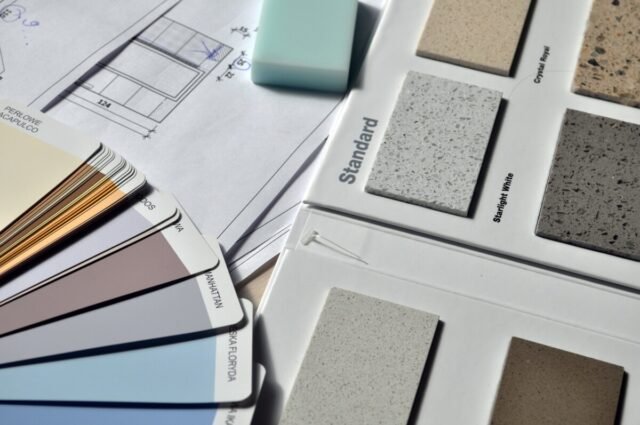Interior design is both an art and a science. One of the key elements of creating an aesthetically pleasing and functional living space is choosing a cohesive color palette. The thoughtful use of color palettes in interior design can transform the look and feel of a room, evoking specific moods and emotions. Understanding color psychology and learning how to effectively implement color schemes is essential for amateur designers and seasoned professionals alike.
The Importance of Color Palettes in Interior Design
A color palette refers to a selective and intentional combination of hues used throughout a space. The colors should complement each other and work together to create a unified aesthetic. Color palettes are one of the most impactful interior design tools for establishing the overall atmosphere of a room.
The right color palette can make a space feel energizing and lively or soothing and serene. On the other hand, a disjointed or haphazard application of colors can make a room feel chaotic and uncomfortable. Using a strategic color palette lends harmony and visual interest to any interior. It also serves as the foundation upon which other elements like furniture, lighting, and decor are layered.
The Psychology Behind Color Selection
In order to choose a color palette that aligns with your vision, it helps to have a basic understanding of color psychology. While reactions to color can be highly subjective, general patterns exist. Warm hues like red, orange, and yellow are known to stimulate the senses and evoke feelings of excitement, enthusiasm, and cheer. Cool colors like blue, green, and purple promote relaxation and calm.
Neutral colors like white, gray, black, and brown are versatile and great for creating balance. They act as a blank canvas that allows accent colors to really pop. Bright, saturated shades tend to energize and vivid pastels have a softening effect. Darker shades can make a space feel intimate and cozy. Being mindful of these psychological impacts can inform your color choices.
Factors to Consider When Selecting a Color Palette
There are several key factors to take into account when choosing a color scheme for your interior design:
Natural Lighting
The quality and quantity of natural light in a space should guide your color selection. North-facing rooms with cool, blue-toned light call for warm color palettes. Southern exposures with ample sunlight can handle darker, cooler hues without feeling dreary. Rooms with bright light and reflections off water warrant light, neutral palettes.
Existing Furniture and Features
Look at furniture, flooring, tile, countertops, and any other fixed elements that are staying put. Choose accent colors that complement these existing features. If you have warm wood tones, incorporate some analogous earthy hues. Cool grays and stainless steel elements pair well with icy blues and silvers. Avoid clashing.
Personal Preference and Purpose
Consider the mood you want to cultivate in each room, as well as your own color preferences. A nursery often works well with cheerful pastels while a home office calls for stimulating shades to boost focus. If you’re not sure where to begin, look for inspiration images that appeal to you.
Size of Space
In smaller rooms, limit your palette to 2-3 colors to avoid looking busy. Larger spaces can handle more varied color schemes with 4-5 hues. Large open concept spaces still need a cohesive palette so the eye flows easily from one area to the next.
How to Select a Harmonious Color Palette
Once you’ve considered the unique needs of your space, follow these steps to choose a harmonious color palette:
Select a Dominant Hue
Begin by choosing a dominant color that sets the tone for your whole palette. This will be the most prevalent shade in the space. Opt for a neutral, muted tone that serves as a solid background. Gray, beige and tan are popular neutral base colors.
Add Complementary Accent Colors
Next, identify 2-3 accent colors to pair with your neutral base. Look at a color wheel to find analogous shades, triadic color combinations, or complementary colors that work well together. Accent colors should play off each other and the dominant hue.
Include Pops of Vibrancy
Add a vibrant secondary color to provide visual interest through contrast. These bright pops of color will make accent walls, artwork, pillows, and accessories really stand out against your neutral backdrop.
Repeat Colors Throughout the Space
Use your color palette cohesively throughout the space on walls, furniture, fixtures, textiles, art and accessories. Repeat colors in different shades and intensities. This repetition creates harmony and flow.
Popular Color Palettes for Interior Design
Certain color combinations have proven to be reliably pleasing and versatile for interior spaces. Here are some of the most popular color palettes to inspire your own creation:
Monochromatic
Monochromatic palettes use different tones, shades and intensities of one single color. This creates a very soothing, cohesive look. Grayscale is a common monochromatic scheme. Adding black and white counts as long as gray remains dominant.
Analogous
Analogous palettes utilize hues that sit next to each other on the color wheel, such as blue, blue-green, and green. They are harmonious and easy on the eyes.
Complementary
Complementary palettes pair contrasting colors from opposite sides of the color wheel, like red and green or yellow and purple. This creates vibrant visual tension. Use complementaries sparingly to avoid overwhelming the space.
Triadic
Triadic palettes use three colors equally spaced on the color wheel, such as red, yellow and blue. The contrast between the colors creates a dynamic, energetic ambiance.
Neutral
Neutrals like white, gray, black and brown serve as excellent base colors to build upon with bold accents. Crisp white paired with pops of color is clean and contemporary.
Tips for Incorporating Color Palettes
Here are some top tips for effectively planning and implementing a color palette:
- Start by collecting inspiration images, fabric swatches, paint color cards, etc. to hone in on your desired look.
- Limit your palette to 3-5 core colors for cohesion, adding other accent shades sparingly.
- Use 60-30-10 ratio, with your dominant color taking up 60% of space, secondary colors 30%, and accent colors 10%.
- Employ your accent colors strategically in small doses to draw attention, such as on ceilings, doors, or as artwork backdrops.
- Repeat your palette colors throughout the space for continuity but vary textures and patterns to add visual interest.
- Display your inspiration images and material swatches in one place to refer back to as you design the space.
- Purchase removable samples of paint, fabric, flooring, etc. to test your palette before fully committing.
- If you have fixed warm wood furniture, incorporate warm earth tones. Cool metals and grays pair well with icy blue and silver hues.
Achieving the Ideal Interior Color Palette
Strategically wielding color is an impactful tool for interior designers to shape the look, feel, and functionality of living spaces. An ideal color palette emerges from a thoughtful process of assessing the needs of the room, the psychology of color, and the interplay between all the design elements.
Experimenting with color mixing and pattern layering allows you to put your personal stamp on a space. Balancing neutrals and saturated hues keeps the palette soothing. Repeating colors ties everything together. With a foundational understanding of color theory and some trial and error, you can curate the perfect color palette for your interior design vision.































